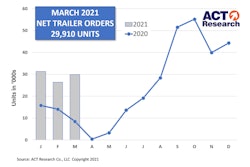
The Heavy Duty Manufacturers Association’s (HDMA) preliminary April results from its Pulse survey indicate supply chain problems continue to proliferate domestically and abroad. The webinar held Wednesday also included Pulse survey results regarding COVID-19.
“The supply chain problems aren’t just in terms of materials or goods, there are massive problems with finding logistics and shipping. Suppliers are reporting meeting 74 percent of OE demand over the month and 72 percent of their aftermarket demand,” said Richard Anderson, HDMA director, market research and analysis.
“So, looking at record high demand levels, what we are seeing from our membership is that the supply chain of which they are a part is not capable of meeting those demand levels,” Anderson added.
In the Pulse survey respondents were asked for their top three challenges to restarting normal business operations. Unsurprisingly, the top concern at 38 percent is procurement of raw material and semi-finished goods, followed by inbound/outbound shipper availability and cost (24 percent), labor force readiness and availability (22 percent) and accuracy of production and demand forecasts (15 percent).
“The news according to our members is that the domestic electronic supply has gotten worse, the international electronics supply has gotten worse and the subcomponent supply is really where things are starting to be the major pain point for many of our members,” Anderson said.
“Freight permeates so many of the [survey] comments. Freight and logistics are the major pain points for all members. There is very little they can do and we have this international problem as well so there’s no relief for anyone in any market,” he said.
A global problem
Analysts from Power Systems Research also presented a global look at issues the industry is having.
“In North America, heavy commercial truck orders have been extremely strong as freight rates remain very high. Both contract rates and spot rates are currently in record territory primarily driven by consumer spending, strong housing market and improving manufacturing sector,” said Chris Fisher, senior commercial vehicle analyst, Power Systems Research
Anticipation of the stimulus spending and increased vaccination rates for COVID-19 are driving optimism in the economy. But supply chain issues, particularly with semiconductors, will be the biggest obstacle to sustainable production in 2021, Fisher said.
[RELATED: Truck, engine OEMs press Biden to alleviate chip shortage amid soaring market]
Similar to North America, demand in Europe started improving during the fourth quarter of 2020 and expects production to increase this year to the level scene in 2019. Europe also is experiencing supply disruptions. Production will be driven by domestic and export demand this year.
“Last year, medium- and heavy-duty truck sales declined by about 26 percent in the EU. However, much like North and South America, order rates have shown significant strength there in the past six months and sales are expected to improve significantly this year primarily in the heavy truck segment. The biggest impediment to improve sales will be issues surrounding supply chains,” Fisher said.
Commercial vehicle demand is expected to improve for much of the South Asia region in 2021. After a 53 percent decline in India in heavy vehicle production, an improvement of around 35 percent is expected this year; however, the region will still be a few years before demand reaches more historic levels.
After a significant decline in medium- and heavy-duty commercial vehicle demand last year, Japan and Korea production is expected to rebound into 2022 for domestic and import markets. “We also would expect bounce back due to vaccinations improving throughout this year,” Fisher said.
In China, semiconductor usage is primarily for components to meet [emission standards] as well as telematics. Ninety percent of semiconductors in China branded MHV are imported from Europe and North America.
“Meeting demand with locally made semiconductors is difficult [in China] — very rigid standards, lengthy testing, heavy investment. It takes years before they can achieve mass production. The shortage should be largely alleviated by the end of the year, but that’s possibly a bit optimistic,” said Erik Martin, director, Asia Region, Power Systems Research.

COVID-19 update
Fortunately for the industry, Anderson said there’s good news on the COVID-19 front.
“The COVID vaccination rate continues to climb and the COVID infection rate continues to decline, although we have not seen either of these have a positive impact on the labor challenges that our members are seeing,” Anderson said.
Survey respondents were asked, compared to the previous month, what is the level of COVID infections across your North America staff. Nearly half reported the number or infections in April were about the same as March and 40 percent reported a small decrease.
Regarding absentee rates, 44 percent of respondents reported a rate of 5-7 percent. Nearly 25 percent reported a rate of 8-12 percent and 20 percent reported a 2-4 percent absentee rate.
“Absentee rates unfortunately for our members continue to hover between 4 to 6 percent. It seems stable but remains a problem. There is obviously tremendous pressure on the labor market right now. Trajectory of the absentee rate, however, is falling slowly for many members and for most of them it is remaining the same,” Anderson said.
[RELATED: HDMA Pulse Webinar covers COVID-19, gridlocked supply]
When asked about current vaccination rate for members’ North America staff, 24 percent reported 30 percent of the staff has been vaccinated. Twelve percent of respondents reported 40 percent are vaccinated and another 12 percent said their staff was over 50 percent vaccinated.
“COVID infection rates continue to decline. That’s obviously good to see. With the overall current approximate vaccination rates within our membership response pool, we see a very large jump by 17 percent,” Anderson says.











